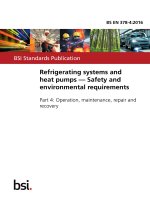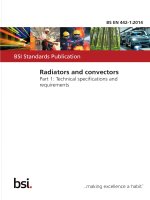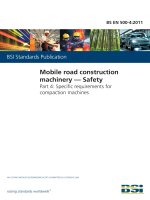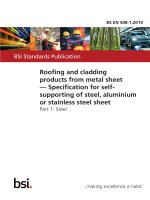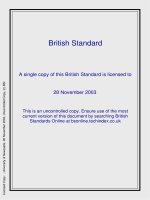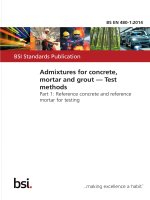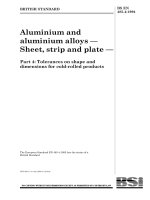Bsi bs en 14154 4 2014
Bạn đang xem bản rút gọn của tài liệu. Xem và tải ngay bản đầy đủ của tài liệu tại đây (1.25 MB, 28 trang )
BS EN 14154-4:2014
BSI Standards Publication
Water meters
Part 4: Additional functionalities
BS EN 14154-4:2014
BRITISH STANDARD
National foreword
This British Standard is the UK implementation of EN 14154-4:2014.
The UK participation in its preparation was entrusted to Technical
Committee CPI/30/7, Volume flow-rate methods.
A list of organizations represented on this committee can be
obtained on request to its secretary.
This publication does not purport to include all the necessary
provisions of a contract. Users are responsible for its correct
application.
© The British Standards Institution 2014. Published by BSI Standards
Limited 2014
ISBN 978 0 580 81298 9
ICS 91.140.60
Compliance with a British Standard cannot confer immunity from
legal obligations.
This British Standard was published under the authority of the
Standards Policy and Strategy Committee on 30 November 2014.
Amendments issued since publication
Date
Text affected
BS EN 14154-4:2014
EN 14154-4
EUROPEAN STANDARD
NORME EUROPÉENNE
EUROPÄISCHE NORM
November 2014
ICS 91.140.60
English Version
Water meters - Part 4: Additional functionalities
Compteurs d'eau - Partie 4: Fonctionnalités additionnelles
Wasserzähler - Teil 4: Zusätzliche Funktionalitäten
This European Standard was approved by CEN on 6 September 2014.
CEN members are bound to comply with the CEN/CENELEC Internal Regulations which stipulate the conditions for giving this European
Standard the status of a national standard without any alteration. Up-to-date lists and bibliographical references concerning such national
standards may be obtained on application to the CEN-CENELEC Management Centre or to any CEN member.
This European Standard exists in three official versions (English, French, German). A version in any other language made by translation
under the responsibility of a CEN member into its own language and notified to the CEN-CENELEC Management Centre has the same
status as the official versions.
CEN members are the national standards bodies of Austria, Belgium, Bulgaria, Croatia, Cyprus, Czech Republic, Denmark, Estonia,
Finland, Former Yugoslav Republic of Macedonia, France, Germany, Greece, Hungary, Iceland, Ireland, Italy, Latvia, Lithuania,
Luxembourg, Malta, Netherlands, Norway, Poland, Portugal, Romania, Slovakia, Slovenia, Spain, Sweden, Switzerland, Turkey and United
Kingdom.
EUROPEAN COMMITTEE FOR STANDARDIZATION
COMITÉ EUROPÉEN DE NORMALISATION
EUROPÄISCHES KOMITEE FÜR NORMUNG
CEN-CENELEC Management Centre: Avenue Marnix 17, B-1000 Brussels
© 2014 CEN
All rights of exploitation in any form and by any means reserved
worldwide for CEN national Members.
Ref. No. EN 14154-4:2014 E
BS EN 14154-4:2014
EN 14154-4:2014 (E)
Contents
Page
Foreword ..............................................................................................................................................................4
Introduction .........................................................................................................................................................5
1
Scope ......................................................................................................................................................6
2
Normative references ............................................................................................................................6
3
Terms and definitions ...........................................................................................................................6
4
4.1
4.2
4.3
4.4
4.4.1
4.4.2
4.4.3
4.4.4
4.5
4.6
4.7
4.7.1
4.7.2
4.7.3
4.8
4.8.1
4.8.2
4.9
4.9.1
4.9.2
4.9.3
4.10
4.10.1
4.10.2
4.10.3
4.11
4.11.1
4.11.2
4.12
4.12.1
4.12.2
4.12.3
General requirements ............................................................................................................................7
Types of additional functionality devices and requirements ............................................................7
Connection requirements .....................................................................................................................8
Environmental conditions .....................................................................................................................8
Security ...................................................................................................................................................9
General ....................................................................................................................................................9
Software, data and hardware security .................................................................................................9
Firmware upgrade of AFD .....................................................................................................................9
Software identification ..........................................................................................................................9
Power supply..........................................................................................................................................9
Data storage ........................................................................................................................................ 10
Clock requirements ............................................................................................................................ 10
General ................................................................................................................................................. 10
Clock synchronisation ....................................................................................................................... 10
Clock setting ....................................................................................................................................... 10
Marking ................................................................................................................................................ 10
Requirements ...................................................................................................................................... 10
Test ....................................................................................................................................................... 11
Documentation .................................................................................................................................... 11
General ................................................................................................................................................. 11
Declaration of conformity .................................................................................................................. 11
Instruction manual .............................................................................................................................. 11
Display ................................................................................................................................................. 12
General ................................................................................................................................................. 12
Requirements ...................................................................................................................................... 12
Test ....................................................................................................................................................... 12
Metrological influence ........................................................................................................................ 12
Requirement ........................................................................................................................................ 12
Test ....................................................................................................................................................... 12
Input to AFD / Output from AFD ........................................................................................................ 13
General ................................................................................................................................................. 13
Requirement ........................................................................................................................................ 13
Test ....................................................................................................................................................... 13
5
5.1
5.2
5.2.1
5.2.2
5.2.3
5.2.4
5.2.5
5.2.6
5.2.7
Additional functionalities ................................................................................................................... 13
General ................................................................................................................................................. 13
Use cases ............................................................................................................................................ 13
Scheduled read ................................................................................................................................... 13
Pre-programmed reading date .......................................................................................................... 14
On demand read.................................................................................................................................. 14
History of consumption ..................................................................................................................... 14
Background leak ................................................................................................................................. 14
Burst ..................................................................................................................................................... 15
Reverse flow ........................................................................................................................................ 15
2
BS EN 14154-4:2014
EN 14154-4:2014 (E)
5.2.8
5.2.9
5.2.10
5.2.11
5.2.12
5.2.13
Zero flow ............................................................................................................................................... 16
Tamper of AFD ..................................................................................................................................... 16
Tamper of meter .................................................................................................................................. 16
Battery low ........................................................................................................................................... 16
Presence of air ..................................................................................................................................... 17
Access profiles .................................................................................................................................... 17
6
Environmental considerations ........................................................................................................... 17
Annex A (normative) Declaration of conformity to EN 14154-4 .................................................................. 18
Annex B (informative) Smart Metering, overview, core functionalities and definitions .......................... 19
B.1
General ................................................................................................................................................. 19
B.2
M2M Gateway ....................................................................................................................................... 19
B.3
Clusters ................................................................................................................................................ 20
B.4
Primary Use Cases .............................................................................................................................. 20
B.5
Secondary Use Cases ......................................................................................................................... 20
B.6
Primary Actors ..................................................................................................................................... 20
B.7
Actors ................................................................................................................................................... 20
B.8
Use Cases ............................................................................................................................................ 20
Annex C (informative) References to EN 14154-1, EN 14154-2 and EN 14154-3 and EN
ISO 4064-1, EN ISO 4064-2, EN ISO 4064-3, EN ISO 4064-4, EN ISO 4064-5 .................................. 21
Bibliography ...................................................................................................................................................... 23
3
BS EN 14154-4:2014
EN 14154-4:2014 (E)
Foreword
This document (EN 14154-4:2014) has been prepared by Technical Committee CEN/TC 92 “Water meters”,
the secretariat of which is held by SNV.
This European Standard shall be given the status of a national standard, either by publication of an identical
text or by endorsement, at the latest by May 2015, and conflicting national standards shall be withdrawn at the
latest by May 2015.
Attention is drawn to the possibility that some of the elements of this document may be the subject of patent
rights. CEN [and/or CENELEC] shall not be held responsible for identifying any or all such patent rights.
This document has been prepared under a mandate given to CEN by the European Commission and the
European Free Trade Association.
According to the CEN-CENELEC Internal Regulations, the national standards organizations of the following
countries are bound to implement this European Standard: Austria, Belgium, Bulgaria, Croatia, Cyprus, Czech
Republic, Denmark, Estonia, Finland, Former Yugoslav Republic of Macedonia, France, Germany, Greece,
Hungary, Iceland, Ireland, Italy, Latvia, Lithuania, Luxembourg, Malta, Netherlands, Norway, Poland, Portugal,
Romania, Slovakia, Slovenia, Spain, Sweden, Switzerland, Turkey and the United Kingdom.
4
BS EN 14154-4:2014
EN 14154-4:2014 (E)
Introduction
This European Standard has been defined as part of the work being undertaken by the European Standards
Organizations (CEN/CENELEC/ETSI) under the Commission Mandate M/441. This standard utilizes the six
functionalities agreed by the Smart Meters Coordination Group (SM-CG) (see Annex B) as the basis for its
additional functionalities. It is not required for the Additional Functionality Device (AFD) to incorporate all
functions defined in this standard.
Communications for water meters are outside the scope of this standard and are covered by the appropriate
parts of EN 13757-1, EN 13757-2, EN 13757-3, EN 13757-4, EN 13757-5 and EN 13757-6 which provide a
number of protocols and transport layers for meter communications for Gas, Water and Heat meters. The
additional functionality for water meters can be provided by a number of methods; these are illustrated below,
see Figure 1, and described in detail within this standard. The AFD can be integrated in the meter, attached to
the meter or remote from the meter.
5
BS EN 14154-4:2014
EN 14154-4:2014 (E)
1
Scope
This European Standard specifies definitions, requirements and testing of additional functionalities for water
meters, without metrological impact, in combination with Additional Functionality Devices (AFD) and in
response to EU/EFTA Mandate M/441 EN. These AFDs are to be considered as “ancillary devices" as defined
in EN ISO 4064-1 and EN ISO 4064-4.
This European Standard does not cover the changing of metrological software within the meter or the
upload/download of metrological software.
NOTE
A manufacturer can claim compliance only for additional functionalities described in this European Standard.
It is not mandatory that an AFD complies with all additional functionalities described herein.
2
Normative references
The following documents, in whole or in part, are normatively referenced in this document and are
indispensable for its application. For dated references, only the edition cited applies. For undated references,
the latest edition of the referenced document (including any amendments) applies.
EN 14154-1, Water meters – Part 1: General requirements
EN 14154-2, Water meters – Part 2: Installation and conditions of use
EN 14154-3, Water meters – Part 3: Test methods and equipment
EN ISO 4064-1, Water meters for cold potable water and hot water - Part 1: Metrological and technical
requirements (ISO 4064-1)
EN ISO 4064-2, Water meters for cold potable water and hot water - Part 2: Test methods (ISO 4064-2)
EN ISO 4064-4, Water meters for cold potable water and hot water - Part 4: Non-metrological requirements
not covered in ISO 4064-1 (ISO 4064-4)
EN ISO 4064-5, Water meters for cold potable water and hot water - Part 5: Installation requirements (ISO
4064-5)
EN 60529:1991, Degrees of protection provided by enclosures (IP Code) (IEC 60529:1989)
3
Terms and definitions
The terms, definitions and symbols of EN ISO 4064-1, EN ISO 4064-2, EN ISO 4064-4 and EN ISO 4064-5,
EN 14154-1, EN 14154-2 and EN 14154-3 apply.
NOTE
Additionally for the purposes of this part of the European Standard, the following terms and definitions only
related to additional functionalities apply.
3.1
functionality
process which constantly or at defined intervals, automatically or on demand, performs specific activities such
as sampling data, reading a data set, verifying or changing a status, or activating a switch
3.2
additional functionality
functionality that a smart meter provides, over and above the metrological functionality covered by the
Measuring Instruments Directive
6
BS EN 14154-4:2014
EN 14154-4:2014 (E)
3.3
additional functionality device
device providing any additional functionality
3.4
additional functionality device type 1 (AFD1)
additional functionality device integrated into the meter
3.5
additional functionality device type 2 (AFD2)
additional functionality device directly attached to the meter
3.6
additional functionality device type 3 (AFD3)
additional functionality device remotely connected to the meter
3.7
automatic meter reading
technology for obtaining metering data from an on-site meter by communication from a remote access point
3.8
universal time coordinated (UTC)
world time, without daylight savings
3.9
reading
primary indication of the total volume passed through the meter
3.10
metrological software
software identified during the type testing examination, which is part of the meter and is critical to its
metrological characteristics
3.11
register
Indication of the specific section in the memory of the control and metering unit that records data as
determined by the programme in the unit
3.12
event
condition requiring action or to log an action
3.13
event log
temporary or mid-term memorized listing of events, containing their occurrence, actions taken and their reset
3.14
interface
point or means of interaction between two systems
4
General requirements
4.1 Types of additional functionality devices and requirements
The additional functionality shall be provided by one of the following devices:
—
AFD1; where all functions are within the same metrological enclosure as the meter;
7
BS EN 14154-4:2014
EN 14154-4:2014 (E)
—
AFD2; where the AFD is attached directly to the meter. The manufacturer shall declare the appropriate
device compatibility;
—
AFD3; where the AFD is located remotely and connected to the meter. The manufacturer shall declare
the appropriate device compatibility.
Figure 1 — Additional functionality devices
4.2 Connection requirements
The AFD2 and AFD3 shall be connected to the meter and tested as a combined unit in all the tests given in
4.11.2 to ensure the connection of the AFD to the meter has no metrological influence.
The connection of the AFD to the meter or any labelling on the meter or the AFD shall not obscure or damage
any metrological seal of the meter.
The primary indication on the meter shall not be obscured by the connection of the AFD and the indicating
device shall be accessible to the consumer without the use of tools.
4.3 Environmental conditions
The AFD shall work with the meter at all operating conditions of the meter as required by the appropriate
standards.
Any AFD should be suitable to meet one of the environmental classes from EN ISO 4064-1, A.2 and A.3 and
the related tests. An AFD3 may have a different environmental class to that of the meter.
8
BS EN 14154-4:2014
EN 14154-4:2014 (E)
4.4 Security
4.4.1
General
The AFD shall be constructed in such a way that any unauthorized intervention shall either cause permanently
visible damage to the AFD or its protective seals, or creates a report in the event log. Any physical seals shall
be visibly fixed, and easily accessible.
4.4.2
4.4.2.1
Software, data and hardware security
Requirement
When tested in accordance with 4.4.2.2 the requirements below shall be met.
All available connections, ports and interfaces of the AFD which can be used for unauthorized adjustment of
the AFDs characteristics and additional functionality shall be effectively secured by protective seals.
No access shall be allowed to software and firmware by unauthorised persons. Software and data shall be
protected against accidental or intentional changes by the breaking of a physical seal or by using an electronic
seal.
For electronic seals the following requirements shall be met:
a)
access shall only be obtained by using a password or a code;
b)
unauthorized intervention shall be registered in the event log and the type of intervention identified, and
where available date and time to be included.
In the case of intended consumer access to the AFD, it shall be ensured that the access by the consumer
cannot inadvertently drain the battery capacity, where applicable.
4.4.2.2
Test
Compliance with the above requirements shall be checked by visual inspection and evaluation of the
manufacturer’s technical documentation.
4.4.3
Firmware upgrade of AFD
This part of the standard covers non-metrological upgrades only, providing there is clear separation between
the metrological and non-metrological functions.
Following any upgrade the information/functionality of the AFD shall be as declared by the manufacturer. Any
data still present shall be the same as prior to the upgrade.
NOTE
4.4.4
An example of a suitable routine is given in the WELMEC Guide 7.2.
Software identification
The software (including version) shall have an unambiguous identifier that is retrievable.
4.5 Power supply
The power supply of the AFD shall comply with EN ISO 4064-1, EN ISO 4064-4 and EN 14154-1 and shall be
tested accordingly.
9
BS EN 14154-4:2014
EN 14154-4:2014 (E)
4.6 Data storage
The AFD shall be capable of storing data such as interval and event data. The manufacturer shall declare
which data are stored and how to access the stored data.
The stored data shall be retained in the event of power failure as tested according to EN 14154-3 and EN
ISO 4064-2.
4.7 Clock requirements
4.7.1
General
Stored data shall be time stamped. The time stamps shall be generated by a clock which gives:
—
a relative time stamp, or
—
a non-synchronized time stamp, or
—
a synchronized time stamp.
It is recommended that the synchronized time stamp within the AFD uses UTC.
The accuracy of the time stamp shall be suitable for its intended use.
4.7.2
Clock synchronisation
If the manufacturer declares that the AFD has a clock that can be synchronised with the clock of the meter,
then it shall be possible to carry out this synchronization.
A record shall also be placed in the event log showing what action was taken.
4.7.3
Clock setting
If the manufacturer allows setting of the clock, access shall only be achieved by the use of an electronic seal
or the breaking of a physical seal.
A record shall also be placed in the event log showing what action was taken.
4.8 Marking
4.8.1
Requirements
When tested in accordance with 4.8.2 the AFD shall as a minimum be marked as follows:
a)
the number and date of this standard;
b)
identification mark or name of the manufacturer;
c)
serial number and year of manufacture;
d)
mark with respective IP rating (EN 60529:1991);
e)
ambient temperature range;
f)
information about the type of battery (for security, transport and recycling purposes);
g)
any additional marking as required by legislation.
10
BS EN 14154-4:2014
EN 14154-4:2014 (E)
With the exception of b), c) and g), if all applicable information cannot be shown on the AFD this shall be
provided on the packaging or with the documentation provided.
4.8.2
Test
This test is carried out by visual inspection.
4.9 Documentation
4.9.1
General
The following information shall be provided with each AFD or group of AFD’s used in the same location.
4.9.2
Declaration of conformity
For each AFD a Declaration of Conformity as per Annex A shall be available in written form or electronic
format and shall identify the name and address of the manufacturer and the date of issue.
4.9.3
Instruction manual
The operating instructions manual shall cover installation, operation and maintenance and shall be available in
written form or electronic format and shall identify the name and address of the manufacturer and the date of
issue. Each AFD or meter-AFD combination or packaging units of those shall be delivered with installation,
operation and maintenance appropriate instruction manuals, including:
—
safe use and hazards arising from misuse and particular features of the design when appropriate;
—
rated operating conditions;
—
mechanical and electromagnetic environment classes;
—
safe disposal and/or recycling guidance;
—
conditions for compatibility with interfaces and type of communication protocol, and
—
storage requirements.
The manuals may include the following optional information:
—
possible installation positions;
—
safety requirements concerning commissioning and de-commissioning procedures;
—
statement if a maintenance is possible and a relevant instruction;
—
way of controlling the proper installation and operation;
—
provisions, if any, for transport and handling;
—
how to trace the right spare parts, and
—
a description of each of the additional functionalities.
11
BS EN 14154-4:2014
EN 14154-4:2014 (E)
4.10 Display
4.10.1 General
This subclause specifies general requirements for an electronic display that may be incorporated in the AFD.
4.10.2 Requirements
Displayed data that is consumer relevant shall be easily legible and available without the use of tools.
When tested in accordance with 4.10.3, information shall be indicated either on:
a)
the display fitted to the meter;
b)
the display of an AFD;
c)
a combination of the above.
The information and flags shall be displayed by means of user action or by means of automatic and sequential
scrolling for at least 10 seconds:
The identification and the unit of each information or parameter shall be clear and unambiguous.
The manufacturer shall declare what information can be displayed.
4.10.3 Test
A test shall be executed by visual inspection.
4.11 Metrological influence
4.11.1 Requirement
When tested in accordance with 4.11.2, the AFD shall have no influence on the metrological characteristics of
the meter.
If the AFD provides a facsimile/copy of the meter’s results, it shall be tested in accordance with 4.11.2 to
ensure these results are identical to those on the meter.
When tested in accordance with 4.11.2 the AFD shall operate with the interfaces specified by the
manufacturer and display the information as specified by the manufacturer.
4.11.2 Test
Test the meter with the AFD incorporated according to the appropriate standard, i.e. EN ISO 4064-1 to ensure
conformity.
Verify the AFD is interoperable with those interfaces specified by the manufacturer. In case of AFD2 or AFD3,
examine the meter and AFD and ensure there is the possibility to apply a protective seal between the AFD
and the meter.
With water passing through the meter under test at the flow rates of Q1 and Q3, operate each additional
function that could have an effect on the metrological characteristics of the meter separately. Operate each
additional function as specified by the manufacturer continuously for 1 h or for a minimum of 10 operations at
Q1 and Q3. The meter performance shall be within the relevant MPE.
Establish a reference result by repeating the identical test procedure with either;
12
BS EN 14154-4:2014
EN 14154-4:2014 (E)
—
the same meter under test with the additional functionalities of the AFD completely disabled, or
—
the same meter with a standard counter without the additional functionalities.
Compare the value reading of the established reference to the value reading of the meter under test and
ensure that the reading has not deviated by more than one third of the MPE.
If the AFD provides a facsimile/copy of the meter under test results, verify that the results provided by the AFD
are identical to those on the meter under test.
4.12 Input to AFD / Output from AFD
4.12.1 General
The manufacturer shall specify the interface to the AFD (e.g. incremental volume pulses or data stream).
4.12.2 Requirement
The manufacturer shall specify the proper connections to and from the AFD.
The AFD instructions shall define the corresponding counterparts or the electrical characteristics and
parameters, the type and method of connection, installation, operating system of the AFD.
When tested in accordance with 4.12.3, a signal as described by the manufacturer shall be detected.
4.12.3 Test
Connect in accordance with the manufacturer's instructions and ensure a signal is recognized and correct
assembly is obvious.
5
Additional functionalities
5.1 General
The additional functionalities to be provided by the AFD are to be described in full by the manufacturer, and
shall comply with the tests described below. The additional functionalities described below are not mandatory
and are offered at the discretion of the manufacturer.
5.2 Use cases
5.2.1
5.2.1.1
Scheduled read
Definition
Scheduled read is the regular transmission of the primary indication in a pre-configured schedule.
5.2.1.2
Test procedure
Modify the calendar date in a way that it simulates the pre-configured schedule and verify that the primary
indication has been transmitted by the AFD.
5.2.1.3
Acceptance criteria
The test is being considered passed if the primary indication is transmitted correctly and without exception.
13
BS EN 14154-4:2014
EN 14154-4:2014 (E)
5.2.2
5.2.2.1
Pre-programmed reading date
Definition
The primary indication will be stored in the memory at a pre-set date.
5.2.2.2
Test procedure
Enter a requirement to store the reading by setting a date for its storage in the memory. Modify the calendar
date to be shortly before the pre-set date. Check if the reading at the pre-set date has been stored in the
memory.
5.2.2.3
Acceptance criteria
The test is being considered passed when the primary indication at the simulated reading date has been
correctly stored in the memory and is retrievable at a later date.
5.2.3
5.2.3.1
On demand read
Definition
Upon request the primary indication of the water volume consumed to date can be established and
transmitted.
5.2.3.2
Test procedure
Request a report from the AFD of the primary indication of the meter and check that the transmission
compares accurately with the primary indication.
5.2.3.3
Acceptance criteria
The test is considered passed if the requested primary indication has been transmitted correctly.
5.2.4
5.2.4.1
History of consumption
Requirement
The AFD may allow storage of the primary indication over a specified period of time.
5.2.4.2
Test procedure
Set the start and end date of the relevant period in such a way that they fit to two known primary indications
and retrieve the primary indications from those dates from the AFD.
5.2.4.3
Acceptance criteria
The test is considered passed if the retrieved indications match the two known primary indications.
5.2.5
5.2.5.1
Background leak
Definition
Either a permanent background flow or, in the case of an indirect feed system after the meter, an intermittent
flow below the expected profile of consumption. This event would normally indicate that an unintentional leak
is occurring after the meter. The occurrence of such an event that deviates from a pre-configured leakage
flowrate range and period of time threshold shall be detected and reported.
14
BS EN 14154-4:2014
EN 14154-4:2014 (E)
5.2.5.2
Test procedure
The test procedure shall be executed as following;
a)
run the meter within the pre-configured leakage flowrate range and period of time stated by the
manufacturer and check that the event is reported;
b)
run the meter outside of the pre-configured leakage flowrate range and period of time stated by the
manufacturer and check that the event is not reported.
This test procedure can alternatively be established via simulation.
5.2.5.3
Acceptance criteria
The test result is considered passed if, in case (a) the event is reported and in case (b) no event is reported.
5.2.6
5.2.6.1
Burst
Definition
A period of flow above a defined, high flow rate. This event would normally indicate that a burst has occurred.
The occurrence of such an event that exceeds a pre-configured period shall be detected and reported.
5.2.6.2
Test procedure
The test procedure shall be executed as following;
a)
Run the meter at 10 % above the defined, high flow rate for the pre-configured period and check the
occurrence of the event.
b)
Run the meter at 10 % below the defined, high flow rate for the pre-configured period and check the nonoccurrence of the event.
This test procedure can alternatively be established via simulation.
5.2.6.3
Acceptance criteria
The test result is considered passed if, in case (a) the event is becoming reported and in case (b) no event is
reported.
5.2.7
5.2.7.1
Reverse flow
Definition
A period of flow in the reverse direction (backflow). This event would normally indicate that reverse flow
prevention measures have failed. The occurrence of such an event that exceeds a defined volume of water
flowing in the reverse direction shall be detected.
5.2.7.2
Test procedure
Run the meter in reverse direction until the defined volume is exceeded. This test procedure can alternatively
be executed via simulation.
5.2.7.3
Acceptance criteria
The test is considered passed when the event has been reported with a tolerance of ± 5 % of the defined
reverse flow volume on the primary indication of the meter.
15
BS EN 14154-4:2014
EN 14154-4:2014 (E)
5.2.8
Zero flow
5.2.8.1
Definition
A period of time with no flow detected. This event may indicate that the meter is failing to operate correctly.
The occurrence of such an event that exceeds a pre-configured period of time shall be detected and reported.
5.2.8.2
Test procedure
Simulate the above pre-configured period of time accordingly.
5.2.8.3
Acceptance criteria
The test is considered passed when after the pre-configured period time of zero flow the event becomes
reported within a ± 5 % accuracy of the pre-configured period.
5.2.9
Tamper of AFD
5.2.9.1
Definition
This functionality only applies if the AFD is sensitive to tampering, in which case the tampering shall be
detected and reported. It is the responsibility of the manufacturer to indicate possible methods of tampering.
5.2.9.2
Test procedure
The manufacturer shall provide a list of consistent test procedures to detect possible methods of tampering.
5.2.9.3
Acceptance criteria
Accordingly, the manufacturer shall provide suitable acceptance criteria for each possible method of
tampering as described above.
5.2.10 Tamper of meter
5.2.10.1
Definition
If the meter is capable of indicating that it has been tampered with, the AFD shall detect and report this event.
5.2.10.2
Test procedure
Simulate an event that the meter has been tampered with.
5.2.10.3
Acceptance criteria
Verify that the simulated event has been detected and reported by the AFD.
5.2.11 Battery low
5.2.11.1
Definition
A battery, which is used to independently operate the AFD, is running low, indicating that the operational life of
the AFD is coming to an end. The event shall be triggered in time to ensure the integrity of the measured data
and allow for appropriate time for the necessary corrective action. The event shall be triggered at least 180
days before the end of the operational life time of the battery.
16
BS EN 14154-4:2014
EN 14154-4:2014 (E)
5.2.11.2
Test procedure
The manufacturer shall supply statistically representative evidence that the occurrence of the “Battery Low”
event allows for appropriate time for the necessary corrective action.
5.2.11.3
Acceptance criteria
The test is being considered passed when the statistical evidence provided by the manufacturer is satisfactory
for the intended purpose.
5.2.12 Presence of air
5.2.12.1
Definition
The presence of air in the pipe system measured leads to incorrect primary indication on the meter resulting in
erratic plausibility from billing period to billing period. If the manufacturer declares that the detection of air is
available, the event should be detected and reported.
5.2.12.2
Test procedure
Run air only through the meter and establish that the AFD detects and reports the event.
5.2.12.3
Acceptance criteria
The test result is considered passed if the event is reported in the AFD.
5.2.13 Access profiles
5.2.13.1
Definition
Access profiles are programmable and pre-settable defined restrictions or sets of restrictions that prevent the
access to certain areas or activities within a smart metering system.
5.2.13.2
Test procedure
Apply defined access restrictions or permissions via the management system to the smart metering system.
Test the integrity of the defined access restrictions and permissions as set.
5.2.13.3
Acceptance criteria
The test result is considered passed if neither a restricted area or action can be accessed nor the access to a
permitted area or action is being denied.
6
Environmental considerations
Further guidance can be found in CEN Guide 4, Guide for addressing issues in environmental product
standards (ed. 3: November 2008).
17
BS EN 14154-4:2014
EN 14154-4:2014 (E)
Annex A
(normative)
Declaration of conformity to EN 14154-4
For each AFD a Declaration of Conformity as per this Annex shall be available in written form or electronic
format and shall identify the name and address of the manufacturer and the date of issue.
Company Logo
Declaration of conformity to EN 14154-4
In the case the AFD is already subject to a declaration of conformity, the following declaration of conformity
may be added to it:
We herewith declare that the following Additional Functionality Device
Type:
AFD 1
AFD 2
Type description:
Type description:
AFD 3
Type description:
is in conformance with the requirements of EN 14154-4 of the current issue
The following additional functionalities have been realised in this product and their function has been tested
according to the requirements laid down in this European Standard
Additional functionality
Realised
√
Communication
bidirectional
√
Communication
unidirectional
√
Clause in
EN 14154-4
Scheduled Read
5.2.1
Pre-programmed reading
date
5.2.2
On demand read
5.2.3
History of consumption
5.2.4
Background leak
5.2.5
Burst
5.2.6
Reverse flow
5.2.7
Zero flow
5.2.8
Tamper of AFD
5.2.9
Tamper of meter
5.2.10
Battery low
5.2.11
Presence of air
5.2.12
Access profiles
5.2.13
Company, town, country, date Name(s) of person(s) responsible
18
BS EN 14154-4:2014
EN 14154-4:2014 (E)
Annex B
(informative)
Smart Metering, overview, core functionalities and definitions
B.1 General
This Annex B is given to show the context of EN 14154-4 within the scope of the SM-CG related to the
mandate M/441.
NOTE
This is taken from the SM-CG technical report CEN/CLC/ETSI/TR 50572:2011.
B.2 M2M Gateway
M2M Gateway is an entity associated with a meter, data concentrator and/or central system providing meter to
meter service capabilities and a data path to these entities.
Key
Definition of the interfaces
H1, H2, H3
Display and Home automation end device interfaces
L, N LNAP / NNAP
Peer interfaces
G
Automated Metering Infrastructure (AMI) to Head End System (HES) interface
C
Neighbourhood Network Access Point interface
M
Metering end device interface
Figure B.1 — Reference architecture diagram for smart metering communications/definition of
interfaces
19
BS EN 14154-4:2014
EN 14154-4:2014 (E)
B.3 Clusters
Clusters are groups of use cases that belong to the same business process.
B.4 Primary Use Cases
Primary Use Cases describe the main functions of a smart metering system. They also describe the behaviour
of the system as it responds to the request of a primary actor.
B.5 Secondary Use Cases
Secondary Use Cases describe core functionalities of the system and interactions that allow Primary Use
Cases to complete. They are started by and deliver to Primary Use Cases only. There is no connection or
interaction with any external actor.
Table B.1 — Examples of Clusters and their associated Primary and Secondary Use Cases
Main Business Process
Groups (Clusters)
Examples of Primary Use Cases
Examples of Secondary
Use Cases
Billing
*Obtain scheduled meter reading
*Set billing parameters
**Read a meter
**Write information
Customer Information Provision
*Provide information to the customer
**Write information
Configure
actions
*Configure meter events and actions
**Invoke an action
**Report event
Installation and configuration
*Clock synchronisation
*Configure AMI device
**Invoke an action
**Write information
Energy market events
*Manage consumer moving in
*Manage consumer moving out
**Read a meter
**Write information
Collect AMI events and status
information
*Manage supply quality
**Report event
**Write information
events,
status
and
B.6 Primary Actors
Primary Actors are for example a Meter Data Collector (MDC), a Meter Operator (MO), a Metered Data
Aggregator (MDA) or a Meter Data Management System (MDMS).
B.7 Actors
Actors are entities that exist outside the system and which take part in a sequence of activities in a dialogue
with the system to achieve a specific goal. Actors may be end users, other systems, or hardware devices.
B.8 Use Cases
Use Cases are descriptions of the interaction between one or more Actors, represented as a sequence of
simple steps.
Each Use Case is a complete series of events, described from the point of view of the Actor.
20
BS EN 14154-4:2014
EN 14154-4:2014 (E)
Annex C
(informative)
References to EN 14154-1, EN 14154-2 and EN 14154-3 and
EN ISO 4064-1, EN ISO 4064-2, EN ISO 4064-3, EN ISO 4064-4, EN
ISO 4064-5
Table C.1 — References to EN 14154-1, EN 14154-2 and EN 14154-3 and EN ISO 4064-1, EN ISO 4064-2,
EN ISO 4064-3, EN ISO 4064-4, EN ISO 4064-5
Feature or Property
EN 14154
Part
EN 14154
Clause.
Metrological Characteristics
1
7
Terms and Definitions
1
3
Operating conditions
EN
ISO 4064
Part
EN
ISO 4064
Clause.
1
3
1
3.3
Q1, minimum flow
1
3.29
1
3.35
Q2, transitional flow
1
3.30
1
3.34
Q3, permanent flow rate
1
3.31
1
3.32
Q4, overload flow rate
1
3.32
1
3.33
1
3.2
Metrological characteristics
MPE, Maximum Permissible Error
1
3.35
1
3.25
Relative error,
Error
1
3.38
1
3.24
7
1
4
Metrological characteristics
Metrological requirements
Permanent flow rate Q3
1
7.1
1
4.1.3
Measuring range
1
7.2
1
4.1.4
Relationship between Q3 and Q4
1
7.3
1
4.1.6
Relationship between Q2 and Q1
1
7.4
1
4.1.5
Reference flow rate
1
7.5
2
4
Maximum permissible error
Accuracy class 2
1
7.6
1
4.2.3
1
4.2.2
Accuracy class 1 water meters
Sign of the error
1
7.6.1
1
7.2.3
7.3.6
Relative error,
Relative error of indication
1
7.6.2
1
4.2.6
MPE lower flow range
Accuracy class 2
1
7.6.3
1
4.2.3
MPE upper flow range
1
7.6.4
1
4.2.3
21
BS EN 14154-4:2014
EN 14154-4:2014 (E)
Accuracy class 2
Accuracy class 1
1
4.2.2
Maximum permissible error in service
1
7.6.5
1
Annex C
Absence of flow
1
7.6.6
1
4.2.9
Meters with subassemblies
1
7.7
1
3.5.2
Technical Characteristics
Technical Requirements
1
4
1
6
Indicating device
1
4.3
1
6.7
General requirements
1
4.3.1
1
6.7.1
Types of indicating device
1
4.3.2
1
6.7.2
1
4.3.3
1
6.7.3
Water meters which utilise electronic devices
Water meters equipped with electronic devices
1
4.4
1
5
Power supply
1
4.4.2
1
5.2
External power supply
1
4.4.2.1
1
5.2.2
Non-replaceable battery
1
4.4.2.2
1
5.2.3
Replaceable battery
1
4.4.2.3
1
5.2.4
1
8
1
Annex A
Verification
devices-First
Verification scale interval
element-
Meter performance requirements
Performance tests for water meters
electronic devices
with
Environmental Conditions
1
Climatic and mechanical environment
Environmental classification
1
8.6
1
A.2
Electromagnetic environment
1
8.7
1
A.3
Operating Conditions
1
Terms and Definitions
1
3
1
3
Rated operating conditions (ROC)
1
3.45
1
3.3.4
Reference Conditions (RC)
1
3.46
1
3.4.5
Limiting Conditions (LC)
1
3.47
1
Annex
1
6
Rated operating conditions (ROC)
1
Annex C
1
6.4
Reference Conditions (RC)
1
Annex C
2
4
Limiting Conditions (LC)
1
Annex C
Operating Conditions
Technical Requirements
22
BS EN 14154-4:2014
EN 14154-4:2014 (E)
Bibliography
EN 60086-1, Primary batteries - Part 1: General (IEC 60086-1)
EN 60086-4, Primary batteries - Part 4: Safety of lithium batteries (IEC 60086-4)
EN 60950-1, Information technology equipment - Safety - Part 1: General requirements (IEC 60950-1)
EN 61010-1, Safety requirements for electrical equipment for measurement, control, and laboratory use —
Part-1: General requirements (IEC 61010-1)
EN 62056-21, Electricity metering - Data exchange for meter reading, tariff and load control - Part 21: Direct
local data exchange (IEC 62056-21)
EN ISO 4064-3, Water meters for cold potable water and hot water - Part 3: Test report format (ISO 4064-3)
WELMEC, 7.2: Software Guide
WELMEC, 11.1: Measuring Instruments Directive 2004/22/EC common Application for utility meters
WELMEC, 11.2: Guidelines on time dependent consumption measurements for billing purposes (interval
metering)
Oiml, R 49-1: Water meters intended for the metering of cold potable water and hot water — Part 1:
Metrological and technical requirements
CEN Guide 4: Guide for addressing environmental issues in product standards (ed. 3: November 2008)
EN 13757-1, Communication system for meters and remote reading of meters - Part 1: Data exchange
EN 13757-2, Communication systems for and remote reading of meters - Part 2: Physical and link layer
EN 13757-3, Communication systems for and remote reading of meters - Part 3: Dedicated application layer
EN 13757-4, Communication systems for meters and remote reading of meters - Part 4: Wireless meter
readout (Radio meter reading for operation in SRD bands)
EN 13757-5, Communication systems for meters and remote reading of meters - Part 5: Wireless relaying
EN 13757-6, Communication systems for meters and remote reading of meters - Part 6: Local Bus
CEN/CLC/ETSI/TR 50572:2011 Functional reference architecture for communications in smart metering
systems
23

